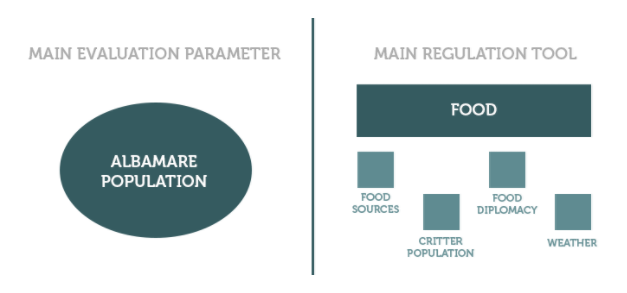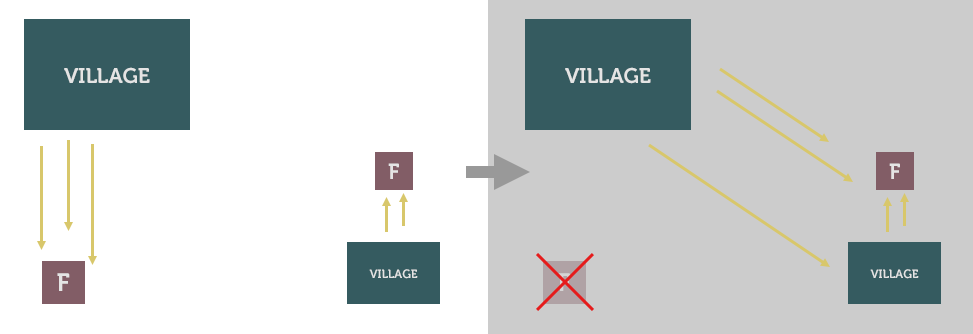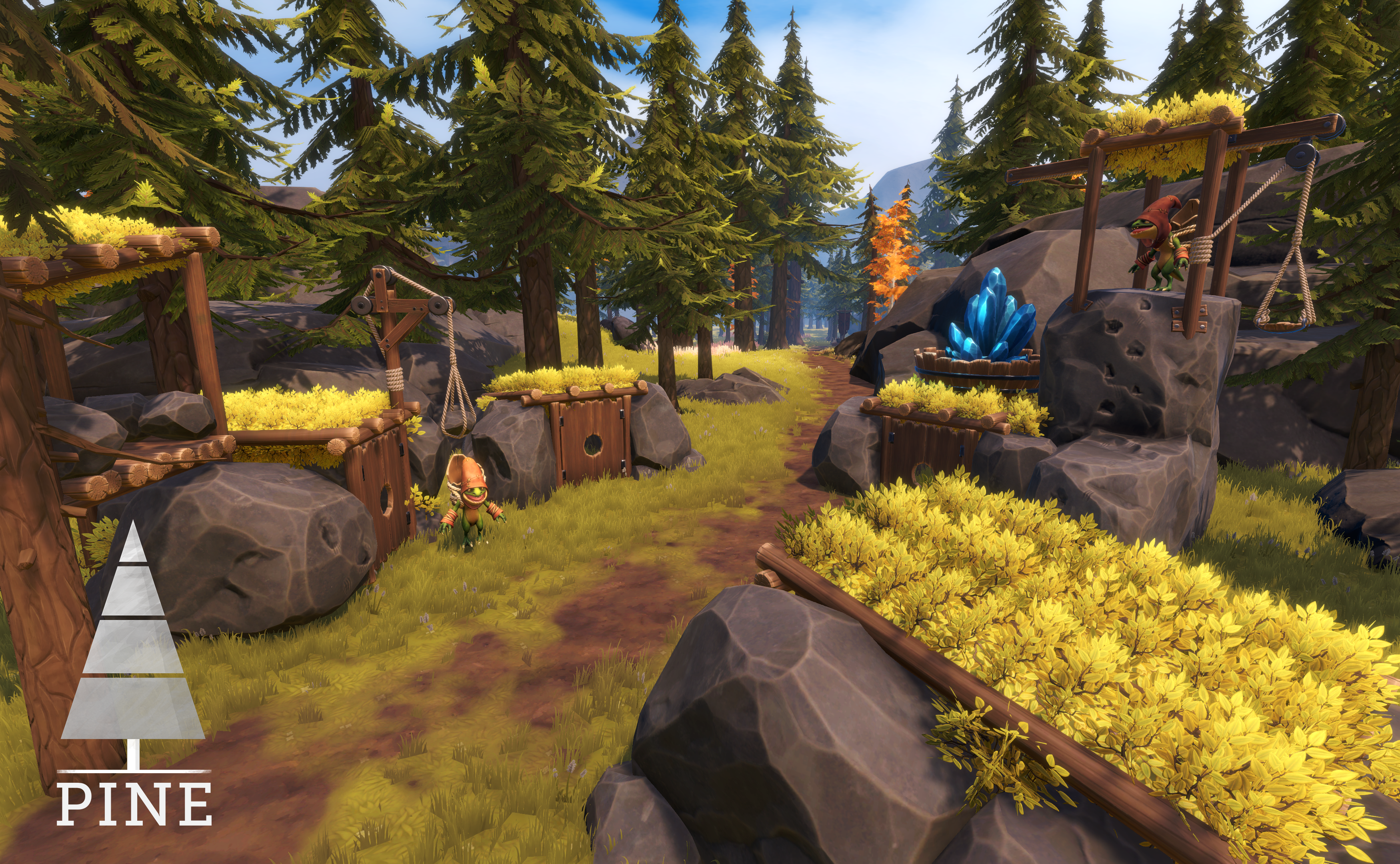Now that we ourselves have a much clearer idea of the game and all its design details, we wanted to spare a moment and write about an important cross section in that design: where simulation meets action-adventure.
Simulation of Albamare
One of the pillars in Pine’s design and structure is a digital simulation of an ecology. On the island of Albamare we treat all organisms equally as we let them gather food, engage in battle with each other, grow their population and look for treasure. Their goal is power, hence they will put their efforts towards increasing that power however they can.
Power means having a large reach, which means having a big population - which equals finding ways to sustain a larger population. And that brings us to food.
When gathered in a simple diagram, the assumption above guides to two important pillars: a main regulation device and a main evaluation parameter.

The main evaluation parameter is important: it is on the experience side for players. This value can heavily decide the pacing, structure and activity density for players. In our case, this is the population of Albamare. With 1000 organisms on the island, you’re bound to get a wholly different experience than with 100 AI actors, so it’s important to get this number right.
But then again, we don’t want to just set a number and leave it at that. The population needs to be regulated systemically to ensure it’s balanced and has some leeway to change without breaking. This is where the main regulation device comes into play: food!

Each village on Albamare has a food supply. Not just for fun - they need it to sustain their villagers, the organisms. Each species has a certain appetite - a Cariblin needs more to keep alive than a Litter, for example. This ensures we can make species very different while keeping them in balance as opposed to each other.
Food can be found all across the island: both static food sources (plants, crops) and dynamic ones (critters) ensure species have plenty of options to keep alive, as long as they move out to get it.
One more cool layer we want to mention is that species have knowledge as a resource too. They 'know' about the world, but they'll have to learn about it first. When moving out of their village, they will learn about food sources nearby and they send out scouting troops to find new food sources. They can then bring this knowledge back to the village, where it's stored, which makes finding food easier next time. Species can even trade this knowledge with each other.
Even without the player’s involvement, the species’ tasks will be performed. But obviously, as a player, you want to get involved - what can you do?
Tools in the simulation
We have three core pillars for gameplay in Pine:
- Exploration: finding villages, discovering new critters, gathering resources to create 'Ideas' with, finding special items, reaching higher vantage points, a bit of puzzling in Albamare's Vaults... Through all of this, you learn about the island and in particular about the species that live on it.
- Diplomacy: talking and trading with villages, placing 'Bounty Bills' on species to stir up the island's political relationships, moving food or food sources... All actions that create power shifts in the ecogical hierarchy or change the affection species have for you.
- Combat: Fighting your way through Albamare is also an option - although no easy feat. Organisms learn from you and, more importantly, have a lot more experience in fighting than Hue does. Better be careful!
We want every action the player does to be applicable to either of these categories to ensure a focused, well-balanced gameplay system. But under this layer of playability lies the continuous simulation, and the two need to work together.
Out of previous assumptions, we drew the logical conclusion that the player should at least be an influencing factor on the main regulation device: food. Therefore, food sources in the world are there for players to use as well: you can gather food from them and bring it to villages, you can consume it yourself, or you can destroy the food or even the whole source altogether.
Finding a food source and destroying it might have large consequences. Given the resource of knowledge for species, a certain tribe might have a nearby food source they attend to - but if you decide to move or remove that source, they will have to scout for a new source or steal food from other species.

We call that action and simulational reaction ripple reasoning. Players can figure out ways to indirectly affect the hierarchy, even though it might spiral into some unexpected results.
Of course, rather than indirectly affecting one of the knobs that defines a tribe's location or population, players can also choose to go at it directly, using combat or trading. Donating food to a village will make life easier for them, while taking it away can seriously disrupt their flow. And, using combat, attacking organisms directly can also impact a village and its status pretty permanently.

Conclusion
Designing Pine as one of the very first action adventure simulation games, we're presented with hugely interesting opportunities. The challenge lies in defining low-level, under-the-hood systems that are inherently balanced, while presenting the player with concrete, fun activities to interrupt these systems.
Pine might be exploring a new subgenre, but regardless of how you would define it, fun is the most important aspect. We want players to dive into Albamare and to come to know its intricacies, while finding out how to influence those themselves. A game doesn't have to be based all around a player - as long as they feel they have a meaningful role in the digital environment.
Stay tuned for more in this year's Fall Demo, where we hope to bring the first fully fledged slice of Albamare's simulated ecology to you!






